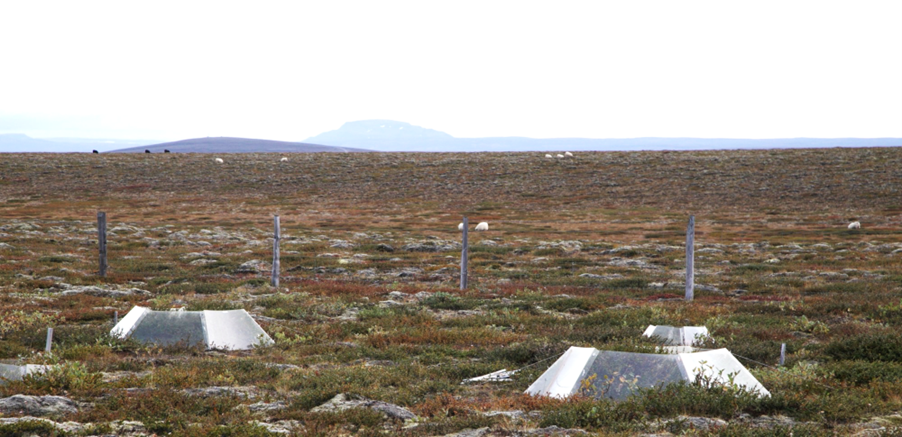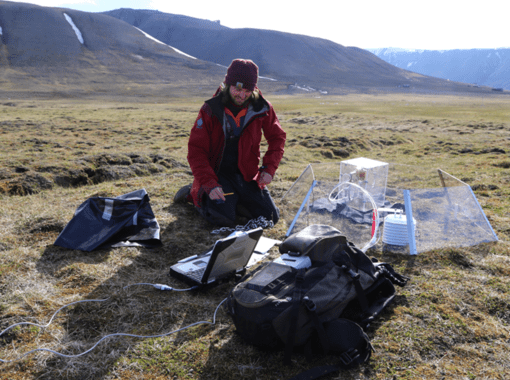The warming climate shifts the dynamics of tundra environments and makes them release trapped carbon, according to a new study published in Nature. These changes could transform the tundra biome from carbon sinks into a carbon source, exacerbating the effects of climate change. Among the authors of the study are scientists from the University of Iceland and the Agricultural University of Iceland.
A team of over 70 scientists used open-top chambers (OTCs) to experimentally simulate the effects of warming on 28 tundra sites around the world within the International Tundra Experiment-network (ITEX). OTCs basically serve as mini-greenhouses, blocking wind and trapping heat to create local warming.

Open-top chambers (OTCs) in Audkúluheiði, Iceland, established in 1996, provide a controlled environment to study simulated warming of the tundra ecosystem.
The warming experiments led to a 1.4°C increase in air temperature and a 0.4°C increase in soil temperature, along with a 1.6% drop in soil moisture. These changes boosted ecosystem respiration by 30% during the growing season, causing more carbon to be released because of increased metabolic activity in soil and plants. The changes persisted for at least 25 years after the start of the experimental warming – which earlier studies hadn’t revealed.
Ingibjörg Svala Jónsdóttir, Professor at the Facultly of Life and Enviromental Sciences, University of Iceland, was the priciple investigator in Iceland and at four sites in Svalbard and there the results were not as clear cut. Measurements at the Icelandic highlands that were done in collaboration with Jón Guðmundsson and Hlynur Óskarsson from the Agricultural University of Iceland showed small responses to warming. Some time has elapsed since those measurements were done (2008) and they will be repeated next summer in collaboration with researchers from the University of Gothenburg.
Measuring carbon fluxes at a mesic site in the Svalbard tundra 2018.

Remarkable increase in respiration
"We knew from earlier studies that we were likely to find an increase in respiration with warming, but we found a remarkable increase – nearly four times greater than previously estimated, though it varied with time and location," says Sybryn Maes of Umeå University, the study’s lead author.
The increase in ecosystem respiration also varied with local soil conditions, such as nitrogen and pH levels. This means that differences in soil conditions and other factors lead to geographic differences in the response – some regions will see more carbon release than others. Understanding the links between soil conditions and respiration in response to warming is important for creating better climate models.
"What makes the study so unique is indeed the assessment of respiration responses to standardized experiments at sites widely distributed across the tundra biome, incorporating a large environmental gradient. This is the strength of the ITEX research network,” says Ingibjörg Svala.
The study also offers a broader perspective on Arctic and alpine regions by predicting increases in respiration across the whole tundra area together with more detailed information about variation in the sensitivity of the response.
"We see that some areas, particularly parts of Siberia and Canada, exhibit greater sensitivity to warming,’ says Professor Matti Kummu of Aalto University. ‘We anticipate an increase in respiration across the whole Arctic and alpine tundra, but more in situ data, particularly on the local soil conditions, is key to addressing the outstanding uncertainties and refining our predictions.’
Understanding how ecosystems shift in response to climate change and how these changes feed back into the climate is vital to get an accurate picture of how our world will change.
These findings serve as an important baseline for improved climate models, but the researchers plan to refine them further by analyzing how the experimental sites change over time and expand the experiment’s scope to include new sites. That applies to the experimental tundra sites that Jónsdóttir initiated in Iceland and Svalbard. In collaboration with the team from Gothenburg Uninvesity the respiration measurements will be repeated this summer and more detailed carbon flux measurements carried out.
The original article in Nature:
Maes, S. L. et al. (2024). Environmental drivers of increased ecosystem respiration in a warming tundra. NATURE (in press). doi: 10.1038/s41586-024-07274-7
Additional reading:




